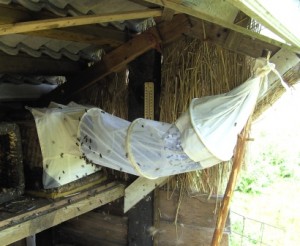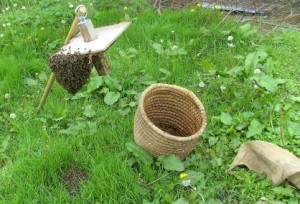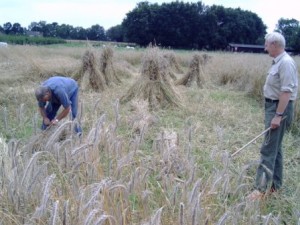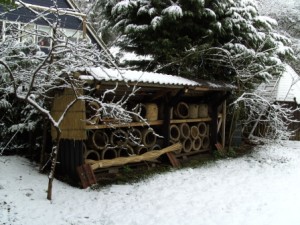In march or april, colonies are brought in the wetlands where willows are dominating. Willows will bring the first abundont nectar and pollenflow for the bees, and this will help colonies not only to grow but also to get sain again, if they are week by illnesses after the miserable days of the long and gray winter.
In the second half of april and in mai, this depends on the weather, colonies are brougt to the orchards for pollinating. Apple, Pear, Prum, Cherises and Blueberries are to be pollinated.
At the end of appleblooming and during the blooming of blueberries, colonies start to swarm. So, those colonies are brought back to the homeapiary, where we will wait for their swarms and catch them. The missing colonies in the orchards are then replaced by colonies that won’t swarm for now.

We catch the swarms with swarmcatching bags, but the swarms that escapes, because we are to late, are mostly catched by swarmcatchers that are hanging in trees etc. It is necessary to treat these swarmcatchers with a lure, that we will made ourselves and that does function better than commercial lures

Some abstract of a not very special swarming day in june can be seen in this videoSwarming goes on till the end of june, yes swarms are always possible if colonies are developping well. But after 6 weeks or sometimes even 8 weeks of catching swarms, it starts to be uneconomically (and boring)to wait for a decreasing number of swarms a day. So if needed, we will made some artificial swarms by knocking bees out of their skeps. How this works, you can see on next video, where some spanish collegaes does the same, but they have skeps of corc instead of straw. We does exactly the same, but the knocking on the skeps we do with our hands, so that the skeps are not damaged. Have a little patience, the bees will start running after 5 minutes.
In juli emphasis is laid on the development of the colonies. They are all weakend by the swarms that have left them, or they were swarms themselves some weeks ago, and have yet to grow to strong colonies that are able to harvest honey from the Heather, calluna vulgaris. We have also

to suppres upcoming swarming desire of some colonies, because now it is to late in saison, and those swarms will not bring anything anymore this year. Colonies are spread over more than 10 stands in a wide area, so they will get better food supply and have less competition among each other.
In august they are brought in the moors and sandy lands, dominated from calluna vulgaris, heathlands also.
When juli has been very wet and august gives us a late summer, the bees will build their combs for heatherhoneycomb production. Heathercombhoney in skeps is better than those gained in modern hives, because wax, that has to be consumed as well, is softer.
Half of september, the bees are brought to the home apiary. Depending on the succes of the multiplication in spring and early summer, it is possible that we can harvest 66 til 75% of the colonies. Before we do so, all honeysupers or boxes for heather combhoney are taken of the colonies. Than after selection, we start shaking or bouncing the bees out of the skeps that has to be harvest. The beeless skeps are brought in a room for breaking out the combs, those will be pressed for heather presshoney. The bees from 1 and a half or 2 colonies or sometimes even 3, will be united till 5 pound bees with one queen and they are sold or will be setup as new colonies. Sometimes bees of harvest stock will be used to refortificate weaker colonnies that are not harvested.

Besides feeding the new made colonies, summer work is done now. But pressing of honey and wax, selling honey, repearing skeps and making new ones, are some of the many tasks that have to be done in winter. So work continues, but the bees don’t dictate me what to do, till it is spring again.